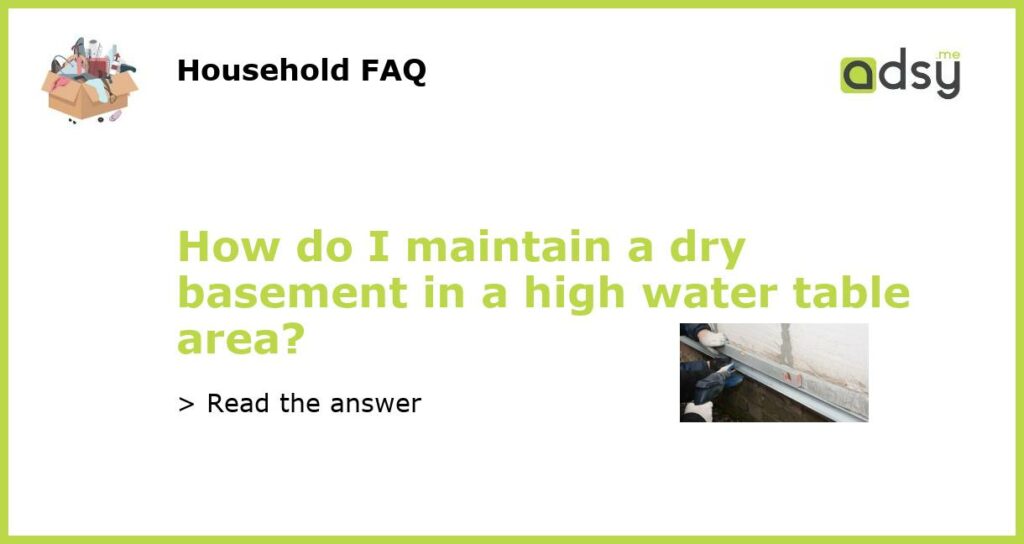Understanding the Problem: High Water Table and Basement Moisture
A high water table is a common issue in many areas, and it can cause major problems for homeowners, especially when it comes to maintaining a dry basement. When the water table is high, it means that the level of groundwater is close to or above the basement floor level. This can lead to a variety of issues, including seepage, flooding, and moisture problems in your basement.
Excess moisture in the basement can cause structural damage, promote the growth of mold and mildew, and create an unhealthy living environment. Therefore, it is crucial to take the necessary steps to maintain a dry basement in a high water table area.
Install a Sump Pump
A sump pump is an essential component in any basement waterproofing system. It helps to prevent basement flooding and excess moisture by removing water that collects in the sump pit. The sump pump automatically activates when the water level rises above a certain point, pumping the water out and away from your basement.
Make sure to choose a high-quality sump pump and have it installed by a professional to ensure proper functioning. Regular maintenance, including checking the pump’s float switch and testing the system periodically, is also essential to keep your basement dry.
Improve the Drainage System
A well-designed drainage system is crucial for a dry basement in high water table areas. The goal is to divert water away from your foundation, preventing it from seeping into your basement. Here are some steps you can take to improve your drainage system:
- Extend your downspouts: Make sure your downspouts are directing water at least 5-10 feet away from your foundation. This helps prevent water from pooling near your basement walls.
- Install gutter extensions: If your downspouts are not long enough, consider installing gutter extensions to further redirect water away from your home.
- Create a slope away from your foundation: Ensure that the ground around your foundation slopes away from your house. This helps to promote natural drainage and prevents water from pooling near your basement walls.
Seal and Waterproof your Basement
In high water table areas, it is crucial to properly seal and waterproof your basement to prevent water infiltration. Here are some steps you can take to achieve a watertight basement:
- Repair foundation cracks: Inspect your basement walls and floor for any cracks or gaps and seal them using an appropriate sealant. This helps to prevent water from seeping through the foundation.
- Waterproof the walls: Apply a waterproofing sealant to the interior or exterior walls of your basement. This creates a barrier that prevents water from entering your basement.
- Install a vapor barrier: In areas with high humidity, installing a vapor barrier can help prevent moisture from seeping through the walls and creating condensation in your basement.
Consider Exterior Drainage Solutions
In addition to improving your internal drainage system, implementing exterior drainage solutions can further help maintain a dry basement in a high water table area. Consider these options:
- French drains: A French drain is a trench filled with gravel or rock that redirects water away from your foundation. It is an effective way to manage water buildup around your basement walls.
- Exterior waterproofing membranes: Applying an exterior waterproofing membrane to your foundation walls can provide an extra layer of protection against water penetration.
Monitor and Control Humidity Levels
Controlling humidity levels is essential for preventing moisture problems in your basement. High humidity can lead to condensation, which can contribute to mold growth and musty odors. Here are some steps to help control humidity:
- Use a dehumidifier: Install a dehumidifier in your basement to remove excess moisture from the air. Set it to maintain humidity levels below 50%.
- Improve ventilation: Ensure that your basement has adequate ventilation to allow fresh air circulation and prevent moisture buildup. Use fans or open windows when necessary.
- Insulate basement walls: Proper insulation can help regulate temperature and reduce the risk of condensation. Insulate your basement walls to prevent moisture from forming on cold surfaces.
By implementing these strategies, you can significantly reduce the risk of basement moisture problems in high water table areas. Consult with basement waterproofing professionals for expert advice and assistance tailored to your specific situation.

